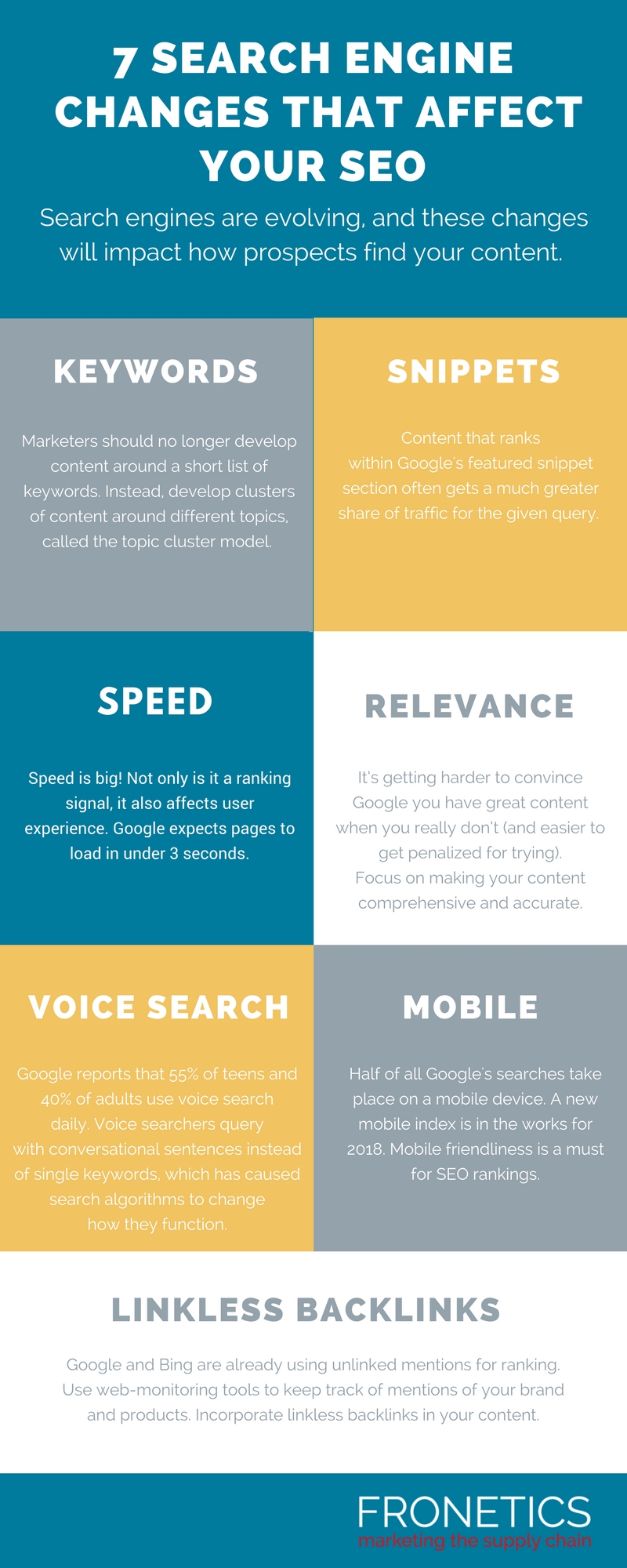
by Fronetics | May 22, 2019 | Blog, Content Marketing, Logistics, Marketing, Social Media, Supply Chain
Social listening describes the process of scanning online platforms to find the sentiment around your brand. Here are 4 ways that social listening can boost SEO.
Highlights:
- Social listening describes the process of scanning social media platforms, blogs, news websites and other digital forums to find the mention of any keywords.
- Regularly monitoring the sentiment around your brand through social listening can help prevent a problem before it blows up.
- Track your organic brand mentions and use that information to create a strategy about how to grow brand awareness.
Video transcript:
This is Elizabeth Hines. I’m the Creative Director at Fronetics, and today we’re talking about four ways social listening can boost your SEO.
Social listening describes the process of scanning social media platforms, blogs, news websites and other digital forums to find the mention of any keywords. In particular the name of your company or your CEO for example, to figure out the general sentiment around your company and your people. We used to use social listening mainly for social media marketing, but it can also be a really effective search engine optimization tool if you do it properly. So here are four ways social listening can boost your SEO.
1. Learn if your backlinks are coming from spammy websites
Backlinks from spammy or untrustworthy websites can negatively impact your search ranking. So a Google executive recently noted that this is just a normal part of being on the web and really you shouldn’t worry that much about it. But the one exception would be if there’s some kind of dedicated activity from a competitor, for example, buying up a lot of links and trying to ruin your search ranking. In this instance you should consider disavowing them and using social listening to figure that out.
2. Find guest blogging opportunities
One of the greatest benefits of social media is the opportunity to network with your industry peers and social influencers. Building relationships with reputable businesses and people could be a gateway to guest blogging, which is one of the most sound and effective ways to build your reputation with search engines, not to mention the people that follow those peer sites and influencers.
3. Monitor your brands reputation
Mistakes happen and even companies with the best intentions will sometimes suffer from a social media crisis. So regularly monitoring the sentiment around your brand through social listening can help prevent a problem before it blows up, goes viral or at least is big enough for Google’s algorithm to down rank you for providing a poor user experience.
4. Grow brand mentions
Now a lot of people will tell you to use social listening to find linkless backlinks, which are websites that mention your content but don’t provide a hyperlink to your site. Then you should reach out to those people and see if they’ll add that link in. But in my opinion, this is an enormous waste of time. We’re seeing that linkless backlinks are becoming equally as important as regular backlinks for search engine optimization. So instead, I encourage you to use that time and energy to track your organic brand mentions and use that information to create a strategy about how to grow more. For example did you say something on Reddit that got lots of attention? Well, you should do more of that.
For more tips like these, check out our blog at fronetics.com.
Related posts:


by Fronetics | Mar 7, 2018 | Blog, Content Marketing, Logistics, Marketing, Social Media, Strategy, Supply Chain
Linkless backlinks, or mentions of your business without a hyperlink to your webpage, are now a more effective way to improve your ranking with search engines.
For years Google has used backlinks to rank webpages. Backlinks are any link on another website that points (or links) back to your website. Unfortunately, search engines began to use backlinks as a bit of a popularity contest: The more you had, the more popular your website became.
Businesses quickly understood the loophole in search engines’ algorithms. They could buy, influence or even create relationships with other industry businesses for the sole benefit of getting links to their websites. It didn’t take long for search engines to catch on.
Google has spent years reworking the way it ranks backlinks and trying to penalize brands that pay for or create free links through unethical relationships. But where does that leave the rest of us that are working to create high-quality content in hopes of increasing our SEO rankings?
Linkless backlinks are the future of SEO rankings
You might be asking yourself what is a linkless backlink? Good question.
Linkless backlinks are mentions of your business or brand without a hyperlink to your webpage. In a keynote speech in September 2017, Gary Illyes, a webmaster trend analyst for Google, said:
“Basically, if you publish high-quality content that is highly cited on the internet — and I’m not talking about just links, but also mentions on social networks and people talking about your branding — then you are doing great.”
It all comes down to mentions of your brand on reputable websites. And I don’t just mean backlinks to your webpage. Other sites’ tweeting about your products or mentioning you on their Facebook News Feed can all lead to increased rankings on Google and other search engines. Sounds easy, right?
How to make linkless backlinks work for you
The principles that help you gain backlinks are still true for gaining linkless backlinks. You want to focus on creating the most accurate, high-quality content you can. Create videos and infographics for your website to add visual appeal. And collaborate with other industry leaders to reach new audiences.
But there are a few other tips you can use to help boost your SEO ranking with linkless backlinks.
3 tips for building a strategy for linkless backlinks
1. Work to increase brand awareness and reputation
The foundation of linkless mentions is reputation building. Search engines are looking for authentic mentions of products and brands in content that helps build authority around an industry topic.
Increase your brand awareness by growing your social media presence, by encouraging followers and loyal customers to write online reviews of your products and services, and by participating in collaborative content marketing.
2. Track brand awareness and mentions
You’re working hard to create content that has a far reach across many platforms. It’s a key step in gaining exposure among potential customers and earning new business. This process is called brand awareness, the extent to which consumers are familiar with your brand. And for linkless backlinks, it’s imperative that you’re tracking all of your brand mentions, not just links.
There are several tools to help you track brand mentions online. Here at Fronetics, we prefer the ease of Google Alerts, which sends you a message when someone mentions your brand online. We also use Hootsuite, with which you can track brand mentions, as well as keywords and phrases, across all of your social media platforms.
3. Stay on top of negative mentions
Blog comment sections and social media channels offer an open avenue for customers to discuss their thoughts about your company for all the world to see. And, unfortunately, one negative comment can be infinitely louder than one hundred positive ones. The potential impact it could have on business is scary.
But that doesn’t mean you should delete or ignore every unfavorable brand mention. In fact, companies can use negative online comments as an opportunity to exhibit top-notch customer service and much-appreciated transparency in the way they do business.
Be diligent in monitoring brand mentions and respond quickly to resolve any issues that arise. Responding promptly and effectively to negative feedback online shows your commitment to customer service and transparency.
The art of SEO building is a tough craft to master. As algorithms evolve, it’s important for brands to stay aware of these changes and focus on what they can do to help boost their rankings.
The more buzz around your brand, the better your ranking will be. So make sure you’re utilizing all the different ways to help boost your SEO ranking, including linkless backlinks.
Need more help with SEO? We’ve done the research, so you don’t have to. Have a look.
Related posts:


by Fronetics | Feb 19, 2018 | Blog, Content Marketing, Logistics, Marketing, Supply Chain
Search engines are evolving, and these changes will have big impacts on how searchers find your content. Here are 7 changes that will affect your SEO.
Internet users are changing how they search, and in response, search engines are changing how they rank content. Newer, more sophisticated algorithms have had big impacts on SEO rankings and the changes haven’t stopped there. Search engines are working around the clock to improve how content ranks for their users. Google and Bing want to ensure its readers are getting the quality content they deserve.
What does this mean for your SEO? It can be very challenging to understand all of the factors that go into a search engine’s algorithm for rankings. Google has over 205 factors that play a part in determining where you content lands in a search and they’re always changing. Instead of worrying about all of those components, here are 7 changes that have big impacts and are easy to integrate into your content.
7 search engine changes you need to know: infographic

Changes to the way search engines work do present a challenge for content creators writing for SEO. But keeping pace with the ever-changing technology is key to keeping your content relevant. Keeping these 7 key changes in mind, content writers can work to integrate these changes into their new content, as well as update older content.
Ultimately, the best way to improve your SEO is through your content. Quality content that is valuable to your target audience should be your biggest priority. With good content and keeping these 7 changes at the forefront, you will be able to optimize your posts and increase the likelihood internet searchers will find them.
Related posts:


by Fronetics | Jan 23, 2018 | Blog, Content Marketing, Marketing
Measuring the success of your content is important in evaluating your writing for SEO strategy. Here’s how to do that.
This week, we’re wrapping up our series on writing for SEO. In this series, we’ve explored how search engines are changing, how people are changing the way they search, and how to make use of topic clusters and pillar content. Now, with a better understanding of the changing SEO landscape, it’s time to think about how to measure the success of your content.
As with any marketing effort, having a documented strategy for your content’s search engine performance — and a plan for measuring the success of your strategy — is key. You might be asking yourself, “How do I measure the success of a piece of content?”
Should I measure the success of one post at a time?
When it comes to SEO, the answer to this question can be complicated, largely because it’s not a great idea to evaluate the success of your campaign on a post-by-post basis. It’s too narrow a definition of success to account for the complex network of direct and indirect benefits of effective SEO writing.
Take brand-driven content, for example. Your focus isn’t about generating individual sales, but rather about elevating your brand, raising wider awareness, attracting new talent, or generating backlinks. If you based the success of brand-driven content on the number leads it generated alone, you’d think it was performing terribly. But your post may, in fact, have generated hundreds of backlinks and be getting lots of traffic.
Evaluating by cluster topic
So how do you evaluate success? Rather than looking at your content on a post-by-post basis, consider how all the content under each cluster topic performs as a whole.
According to HubSpot, “Measuring the entire topic cluster against all of your core business metrics will enable you to include residual benefits coming from content that doesn’t align with direct conversion goals.”
As you look at the performance of your topic clusters, consider the following four questions:
- Which topics perform best at driving traffic to your website or other web presence?
- Which topics earn you the most leads?
- Which topics drive the most revenue for your business?
- Which topics earn the most backlinks/coverage?
It’s important to remember that at the end of the day, what you’re working toward — and what will work best for your search visibility — is creating content that people want to see. Writing for SEO is ultimately about creating better content, increasing search engine visibility, and providing the best possible experience for your site visitors.
Related posts:


by Fronetics | Nov 6, 2017 | Blog, Content Marketing, Marketing
Use these four tips to earn high-quality backlinks that will boost your company’s search engine ranking.
It’s no secret that backlinks can help your search engine rankings. Backlinks are any link on another website that points (or links) back to your website. Since the 1990s, search engines have used backlinks as a bit of a popularity contest: the more you had, the more popular your website became.
It didn’t take long for companies to hunt for backlinks, creating relationships with other companies in the same industry for the sole benefit of getting links to their websites. But like all relationships, link building can be abused and, often times, only beneficial to one party. Pursuing links for search engine ranking alone creates a negative mindset, leading to uneasy relationships, damaged brand reputation, and low-quality, spammy links.
How can you achieve high-quality backlinks?
Let’s start by understanding what constitutes a high-quality backlink. SEO consultant Mark Walters defines them as links that:
- Are from a relevant and trusted source
- Have anchor text that matches your keywords
- Are on a page with Google’s PageRank
- Are next to backlinks to authority websites
- Are from different sources
- Are not reciprocal
- Are on pages with few other backlinks
Now that you know what defines a high-quality backlink, how can your company achieve these organic relationships? The answer is hard work.
Here are 4 tips to help your efforts get high-quality backlinks.
1. Create the best content available on your topic
The best content is content that is unique. Not only is original content SEO friendly, original content is audience friendly. In one minute, users share 300 hours of video on YouTube and tweet nearly 400,000 tweets times. If you want content that stands out, you need content that differs from that of the rest of the pack.
You can make content stand out by using winning headlines, graphics, images, and with great writing. Create every single piece of content with your current and prospective customers in mind. Content that attracts and engages audiences effectively communicates valuable information, providing knowledge to help guide informed decisions. Creating reliable information will establish your website and business as a thought leader within your industry, and other companies will start to take notice.
2. Perform exclusive interviews with industry experts and/or influencers
The strategy of interviewing industry experts is becoming more and more common. Here at Fronetics we often interview influencers. The draw from big names helps bring in new traffic to our site, as well as provide readers with the latest happenings in our industry.
“The benefits of creating content around authority figures in your space is vast, such as bringing recognizable authority names to your site, while also having the opportunity for such content to be shared by featured experts as well. The end result could create lots of great content for your site, while also bringing in a nice consistent supply of new traffic as well.” Writes Zac Johnson for Business 2 Community.
3. Create custom infographics
Images are a fail-safe way to create engaging content, but infographics do more than just give readers visual knowledge. Infographics also help achieve backlinks. They provide interesting and valuable information using images, giving readers the knowledge without having to read through heavy text. The most popular infographics incorporate amazing design and well-researched statistics.
According to HubSpot, social media users share and like infographics 3x more than other any other type of content. Good infographics have the ability to make your content go viral, generate tons of high-quality back-links, and improve your site’s overall SEO.
4. Participate in collaborative content marketing
Collaborative content has many benefits, but one of the biggest is reach. Your collaborators have their own followers and platforms. Combine that with your audiences, and your content is already reaching more people. These collaborations save time and money and will earn you backlinks through the other participants. Collaborative content will help drive organic traffic, provide valuable and relevant information, and introduce a new voice to your content.
Using these four strategies will help your company earn high-quality backlinks and start improving your search enginge ranking. Your higher rankings will come from organic backlinks that your hard work helped to create.
Related posts:










